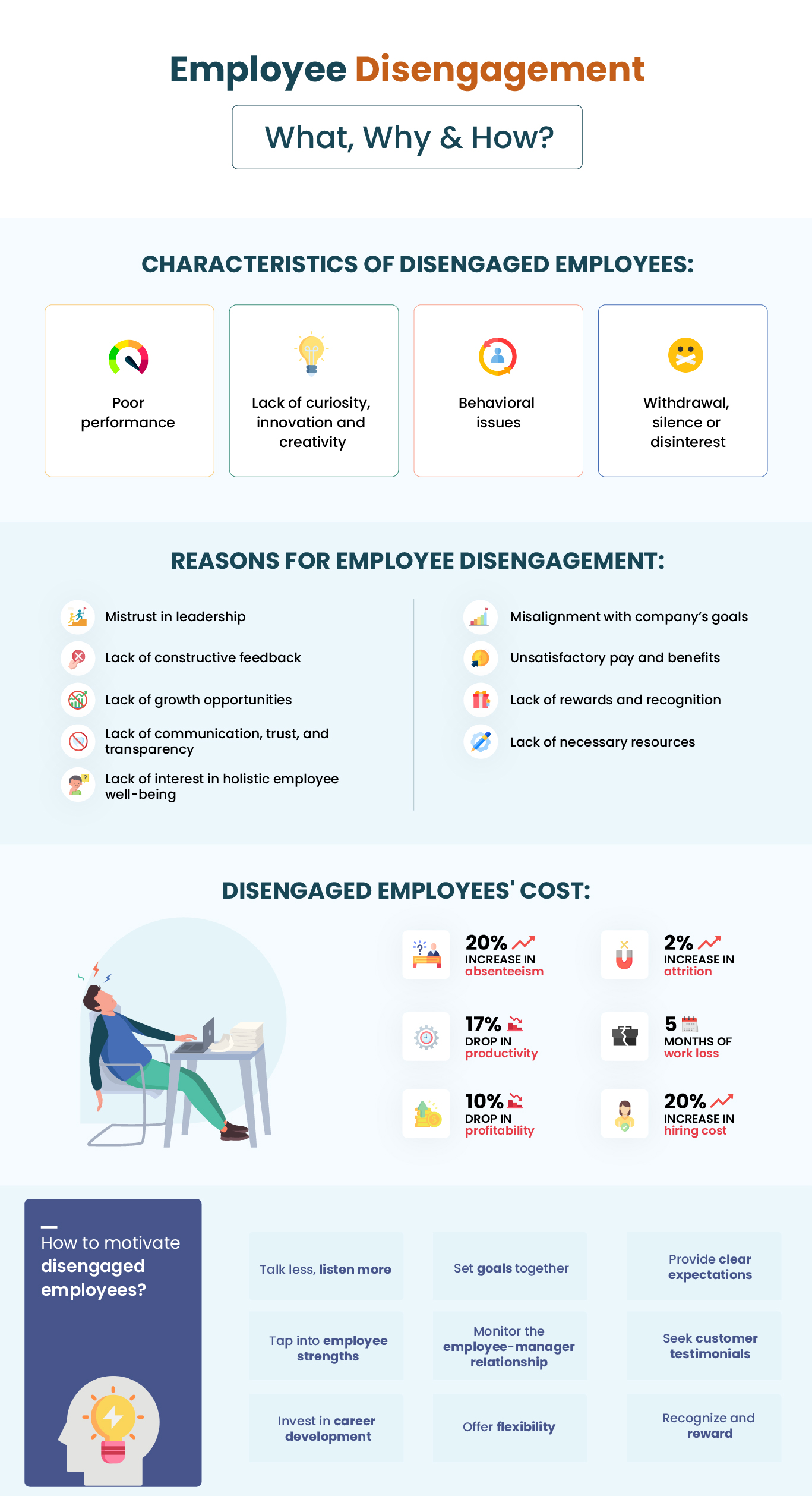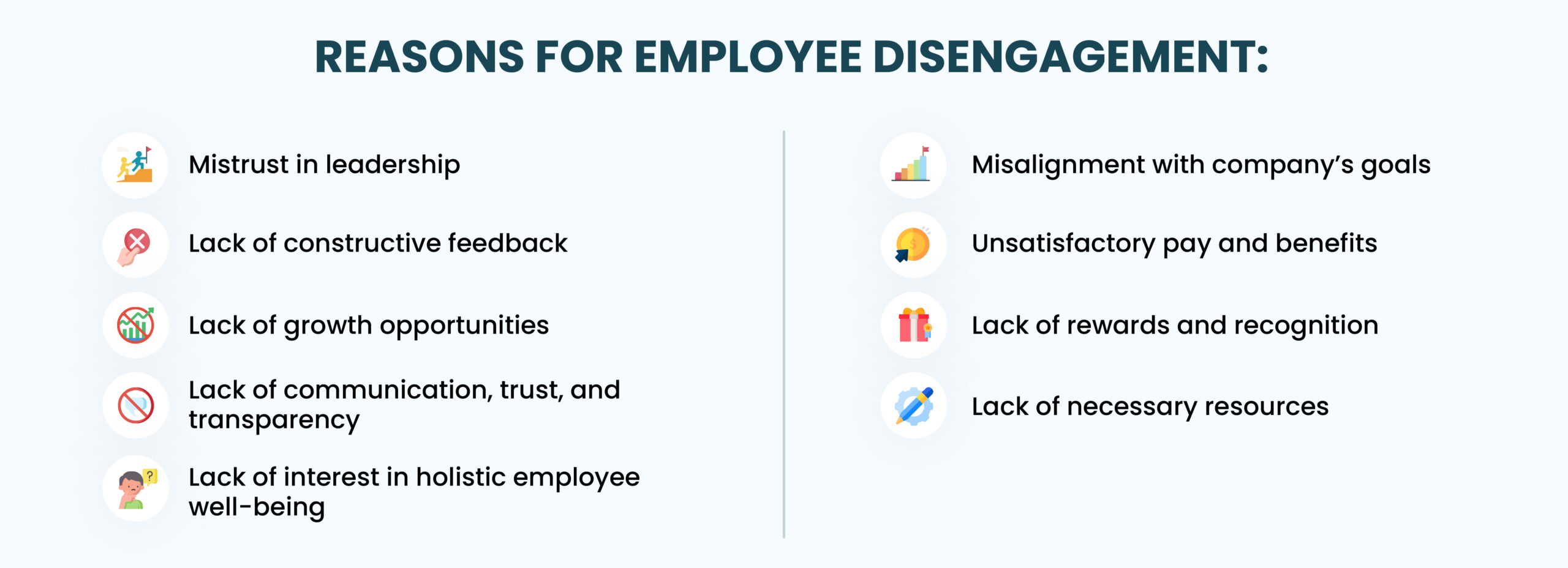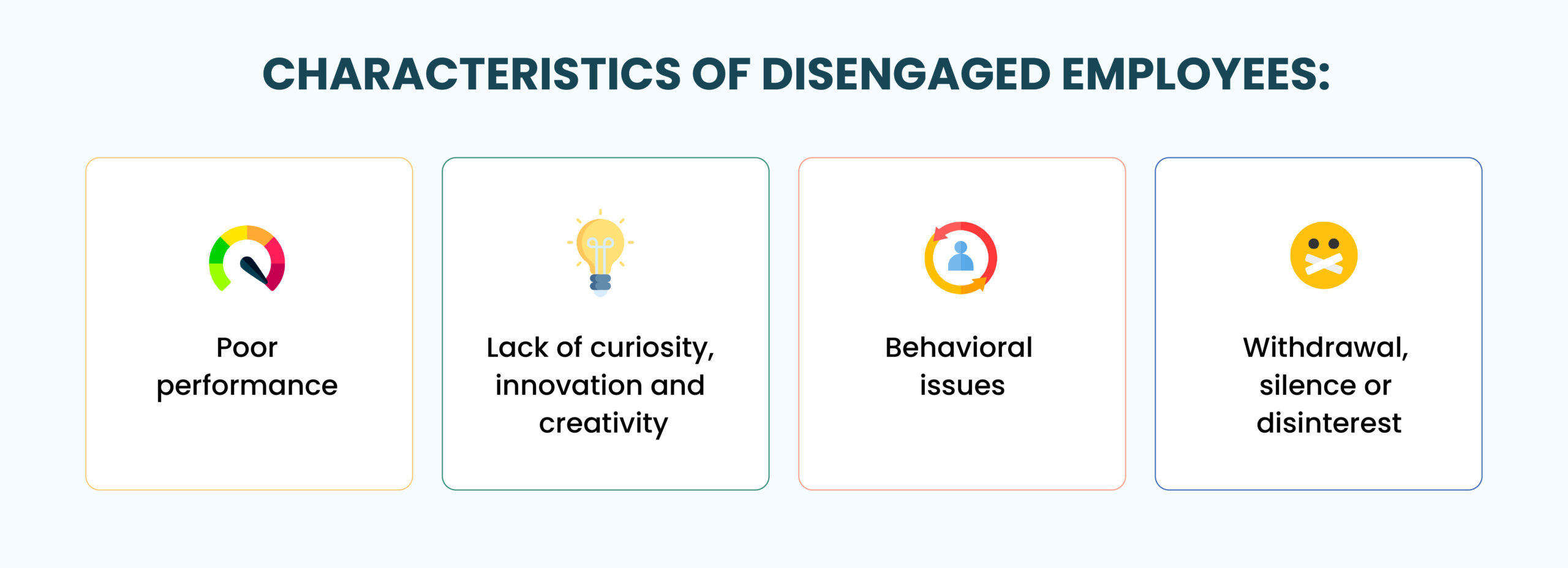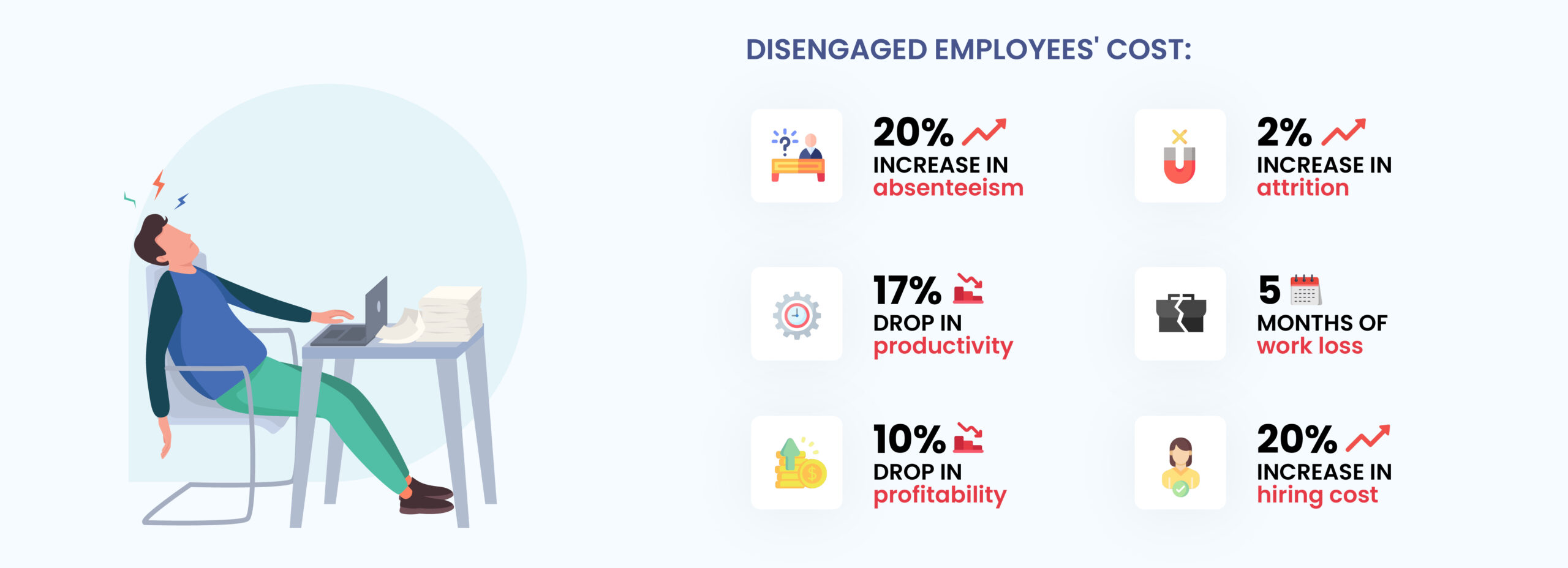When starting a new job, employees are extremely happy and excited about their new roles. Employers are supportive, colleagues are friendly, and the whole environment is welcoming. But after one year, this excitement starts to fizzle out, and employee engagement starts declining. Every company will witness at least one of the many causes of employee disengagement at work at some time, which can lead to significant problems in the workplace. Not only does the individual perform poorly, but often it can have a negative impact on the morale and motivation of the larger team.
An actively disengaged employee, no matter how skilled they are, will not work to the best of their productivity. They are unmotivated, disconnected, and are possibly looking out for a new job. Or, they are making working with them challenging for their peers and managers, eventually impacting their morale and productivity too.
A disengaged employee’s affectd an organization in compelling ways, such as increase in employee absenteeism, lower levels of productivity, and eventual increase in hiring cost. So why do employees become disengaged, and how can you deal with them? That’s what we’re going to discuss in detail in this blog.

What is a Disengaged Employee?
A disengaged employee is one who doesn’t have a sense of loyalty or commitment towards their organization. They do their bare minimum part and don’t put any extra effort into their work, contrary to an engaged employee who is willing to go above and beyond at work.
They don’t bring any passion or energy to their work and do not care about the company as a whole. This not only affects the productivity, performance, and output of that particular employee but also impacts the employer and co-workers around them.
Why Do Employees Become Disengaged?
Now, let’s look at what may be some of the major causes of employee disengagement at work.

Mistrust in leadership
The relationship between employees and their managers and leaders plays a crucial role in employee engagement. Psychologically absent leaders do not make time to meet their team, provide support and constructive feedback, give recognition, or worse, micromanage their teams. They constantly take credit for the work of their team members and fail to build meaningful connections with their teams. This leads to high levels of stress, low employee morale, and ultimately causes employee disengagement. Poor leadership, lack of leaders to look up to, and bad rapport with managers are primary causes of employee disengagement.
Lack of constructive feedback
Getting clear feedback is one of the critical aspects of effective communication. Employees who never receive guidance about their work, strengths, weaknesses, and potential improvements don’t feel like working towards achieving their goals, leading to reduced motivation and ultimately disengagement at work. A lack of feedback results in a lack of purpose – employees feel they aren’t being given feedback because their work doesn’t matter to the organization.
Lack of growth opportunities
Career growth and development are important for employees. In fact, it is one of the crucial factors that helps an employee decide whether to stay within your company or not. So, if you’re expecting more engagement from your workers, you must provide them with adequate training and learning resources to thrive. Without it, it’ll be hard for them to know how to excel in their careers and understand how their career path may look within the company. Lack of upskilling and l&d initiatives can be causes of employee disengagement.
Lack of communication, trust, and transparency
For employees to be constantly engaged – transparent, honest, and consistent communication in the workplace is essential. Workers must know what their managers expect from them. They also need clear and honest feedback about their work strengths and weaknesses. Without knowing this, they won’t be able to improve or understand where they’re headed in their roles. This will further make it difficult for them to focus on work, leading to disengagement at work. Poor communication leads to lack of transparency and trust in the organization, forcing a disengaged employee to become an actively disengaged employee.
Lack of interest in holistic employee well-being
Employee well-being is a critical aspect of employee engagement. Organizations that show massive interest in these factors are more likely to have an engaged workforce. Not only can it help reduce stress but also prevent burnout in the workplace. Therefore, if you’re not investing in employee wellness initiatives yet, it’s high time you consider that. Stress, burnout, and hustle are all part of work, and the responsibility of addressing these lies with the organization, failing at which can cause employee disengagement.
Misalignment with company’s goals
Organizations hire employees who are a good fit, similarly employees join organizations that are in-line with their goals and values. An employee who values work-life balance will not join an organization with erratic work timings. Similarly, employees who value diversity, equity and inclusion in the workplace would want their organization to have similar values. It is important for employers and employees to be on the same page and have a shared vision for the organization as well as the employee.
Unsatisfactory pay and benefits
Inadequate pay and benefits are leading causes of employee disengagement. Financial stress contributes to disengagement in the workplace. If employees aren’t paid worth their time and effort, they don’t feel invested in their work. When they’re worried about their rent, groceries, and child care, they are less likely to be enthusiastic, and it’s difficult for them to engage fully in the workplace.
Lack of rewards and recognition
Employee recognition programs are among the most successful employee engagement strategies for improving engagement. Employees love when their managers see and acknowledge their hard work. But, if your employees are pouring their heart and souls into their work and rarely receive any reward for their achievement, they’ll eventually burn out and become disengaged. Further, a substandard, non-personalized recognition program won’t make sense and might do more harm than good to employee engagement.
Lack of necessary resources
Employees are more satisfied and perform their best if they have the necessary tools and resources to do their jobs. Poor or limited technology can frustrate them and prevent them from having a great employee experience. Further, they may find their jobs so overwhelming that it may be harder for them to succeed, resulting in disengagement at work.
All of these can lead to a toxic work culture where employees constantly feel unhappy, unsatisfied, and unmotivated to work. Whether it’s just one or more, they can amount to becoming the primary causes of employee disengagement.
What are the Signs of a Disengaged Employee?
Now that you know what are the causes of employee disengagement, keep an eye out for the following characteristics of disengaged employees – the red flags:

Poor performance
One of the first signs of disengagement is a decline in an employee’s performance. Failure to meet timelines or take work seriously, giving excuses for a work done poorly, an unwillingness to make efforts to improve performance, etc. are some signs of a disengaged employee.
If your hard-working employee is no longer producing the same output they used to, they’re likely not engaged in their work. Such employees don’t aim for maximum quality. Instead, they may be doing enough to get paid or not get fired from their job.
Lack of curiosity, innovation and creativity
Losing the curiosity to learn new things, a lack of creativity in work, failure to contribute to new ideas and projects, and losing the passion to strive for something new and better are some of the characteristics of disengaged employees.
Behavioral issues
It’s normal for employees to occasionally move around the office or chat briefly with their colleagues. But, the problem arises when this becomes excessive. For instance, if an employee has a computer job but rarely sits on their desk and is seen wandering around the workplace, it might be cause for concern.
Disengaged employees won’t feel motivated to wake up in the morning and rush to work on time. They leave the office at random times or take excessive lunch breaks. Increased absenteeism, taking too many breaks, disregarding peers and managers, can be some cause for concerns and signs of a disengaged employee.
Withdrawal, silence, or disinterest
Oftentimes, employees continue to do their bare minimum but go silent – they don’t participate in group activities or show disinterest towards any kind of involvement at work.
Disengaged employees no longer feel connected to the company and their team members. Moreover, they avoid indulging in any non-necessary activities and limit the amount of time they spend with their peers. Withdrawal can likely be a sign of disengagement at work.
Disengaged Employees’ Cost: What Happens When Employees are Disengaged?
When employees are engaged, it will positively impact your business. But, if your company has a disengaged workforce, it can have the exact opposite effect.

Here’s what a disengaged employee is actually costing your organization:
Loss of productivity
Disengaged employees make more errors and cannot focus on the work at hand, negatively affecting the organization’s overall productivity. Further, a lack of concentration and partial or no enthusiasm can make them spend extra time and resources at work, resulting in reduced efficiency. Decreased productivity can also have an upsetting effect on customer experience, as well as overall revenue and profitability.
Increased absenteeism
Disengaged employees are likely to be more absent from work, causing loss of productive work hours. It could also be a sign of stress, burnout, or increased workload, and should be addressed by the organization. Occasional absenteeism is not bad, but frequent leaves mean they are not dedicated to their jobs and are making excuses to avoid it, or need help to balance their work and personal life.
High churn
Disengaged employees aren’t committed and don’t see a long-term future with the organization. They don’t feel attached to their jobs and are continuously planning for an escape route. Employee attrition can cost millions to your company. Not only are precious work hours being lost because the disengaged employee is doing the bare minimum while they are in the job, once they leave, the cost to replace them and the time taken to onboard the new employee all adds up to be consequential.
Impact on culture
Building a positive company culture involves participation from everyone, and employee disengagement can cause numerous difficulties. Disengaged employees are counterproductive to building a healthy work culture, and hamper team spirits and collaboration. While engaged employees can contribute to a positive vibe in the organization, disengaged workers can be infectious and often bring down the morale and motivation of their peers and manager with them.
How do you deal with actively disengaged employees?
Figuring out how to deal with disengaged employees can be challenging for HR teams and managers.

Talk less, listen more
Disengaged employees have lots of potential but often feel that they aren’t being heard. So, great HR leaders should talk less and instead listen to what disengaged employees have to say, encourage them to explain their concerns, and understand the root cause of their disengagement to take required actions.
Set goals together
Collaborating goal setting plays a significant role in boosting employee engagement, improving performance, and benefiting the organization. In other words, leaders who help align personal goals to company and team priorities and initiatives experience a highly engaged and motivated workforce.
Disengaged employees may simply be floating within the organization without any purpose. But, with the combination of a clearly defined deliverable and fixed deadline, you can help employees refocus their attention and allow them to work in a structured and effective manner.
Provide clear expectations
Employees who are left on their own and aren’t clear about their performance will quickly become disengaged, especially if no clear expectations are set. So, it’s the responsibility of the HR managers to set and communicate clear expectations you have for employees and link them directly to your overall business plan. Also, let employees decide how to meet those expectations.
Further, review these expectations regularly, focus on the results, and tell your employees how crucial these are for the overall team performance.
Tap into employee strengths
Employees want to perform their best, but not everyone can make that happen — one of the reasons they feel disconnected from the company. Therefore, managers must communicate with employees to understand their strengths and uncover hidden talents that could transform the business.
While working closely with them, if you realize that someone is better suited for another role, provide them opportunities to make a move. When leaders focus on employees’ strengths, it boosts their morale, retention, and ultimately engagement.
Monitor the employee-manager relationship
Let’s get real, employees don’t quit their jobs but quit their bosses. Employee engagement depends highly on work relationships. While most employees feel connected with their co-workers, fewer workers might feel the same about their managers.
So, encourage your leaders to spend time with their employees and get to know them. Communicate with them, ask them about their goals, aspirations, problems, and feedback, and act on their suggestions if possible. When employees feel that their managers care about them and their opinions, they are more likely to come up and experiment with innovative ideas, share information, and support peers.
Seek customer testimonials
Customer satisfaction can be a surprisingly effective way to drive employee engagement. Dive into the customer base, find out stories of how your employees have made their lives simpler, and share them with the entire company as well as potential customers. When disengaged employees see the positive impact of their efforts on customers, engagement will start rising.
Invest in career development
Organizations that make career development a top priority and show that they are invested in employee success are likely to re-engage their workforce.
Most employers complain that their companies offer few opportunities for learning and development, resulting in dissatisfied employees and eventually disengagement at work. To motivate them, consider creating an employee development plan to help them grow within their jobs and acquire new skills.
You can also create personalized training programs, send employees for webinars and conferences, depending on the skills your employees want to develop. Online learning resources can allow workers to complete modules at their own pace, anywhere. Plus, these can perfectly fit the more flexible working arrangements that today’s workforce demands.
Offer flexibility
Due to the increased transition towards remote working, the 9-5 working era is gradually fading away, with employees swapping traditional working hours and locations for flexible and work-from-home opportunities. So, instead of offering annual bonuses to motivate your team, think about providing a flexible work schedule or allowing them to work remotely — if the nature of your business allows it.
Employees who have control over their time can customize their working hours as per their needs, are more productive and happier, and are proven to work harder towards achieving the company’s goals.
Recognize and reward staff
Disengagement at work can often arise when employees feel that they’re not being appreciated for their hard work. Managers forget about calling out employees for their accomplishments and provide feedback when there is a problem.
One of the easiest and most effective ways to re-engage your workers is by telling them how much you appreciate their efforts and how their contributions help the organization achieve its goals. When employees feel recognized and rewarded, they become more engaged in their work and become motivated to go the extra mile to achieve company goals.
However, you don’t have to develop an expensive program to reward employees. Sending them a simple thank you note, praising them during stand-up meetings, or recognizing them as an employee of the month can go a long way in making a positive difference.
Invest in providing your employees a great experience, and you’d have already taken care of most of the things mentioned above.
Summing up
Thousands of companies worldwide struggle with employee disengagement. In fact, it can be an epidemic in the workplace and should be dealt with utmost seriousness.
Whatever may be the causes of employee disengagement, the onus of taking the first step lies with the organization. Once organizations realize what employee disengagement actually costs, we hope that organizations will start taking small steps, and implementing activities and ideas that can result in better employee engagement.
With HR tools like Leena AI, you can leverage smart automations to keep a close watch on how engaged your employees are, understand the cause of employee disengagement in your organization, and get actionable insights to prevent disengagement at work.
Interested in how companies are improving employee engagement?
Book a demo of Leena AI todayFrequently Asked Questions
What causes employee disengagement?
The following are some of the causes of employee disengagement:
- Mistrust in leadership
- Lack of constructive feedback
- Lack of growth opportunities
- Lack of communication, trust, and transparency
- Lack of interest in holistic employee well-being
- Misalignment with company’s goals
- Unsatisfactory pay and benefits
- Lack of rewards and recognition
- Lack of necessary resources
How does employee disengagement impact attrition?
Closely linked with each other, employee disengagement and employee attrition are an emerging concern for organizations. Employee disengagement is one of the biggest contributors to employee attrition, making employees lose interest in their work, become disconnected with their organization, lowering their productivity, increasing absenteeism, and ultimately leading to attrition. Actively disengaged employees spend less time in their current work and more time looking for a job outside. A vicious cycle – increased instances of attrition can cause employees to get disconnected and concerned about their organization and in turn lead more employees to resign.
How to motivate disengaged employees?
Here are some ways you can motivate disengaged employees and re-engage them:
- Talk less, listen more
- Set goals together
- Provide clear expectations
- Tap into employee strengths
- Monitor the employee-manager relationship
- Seek customer testimonials
- Invest in career development
- Offer flexibility
- Recognize and reward







3 Comments